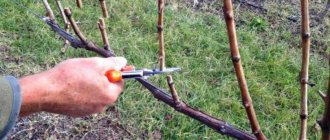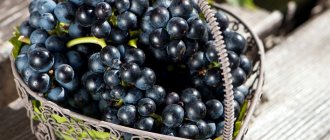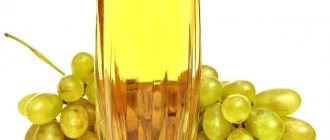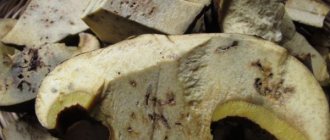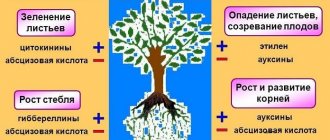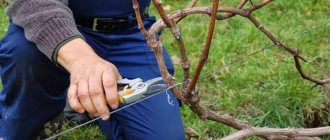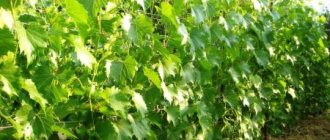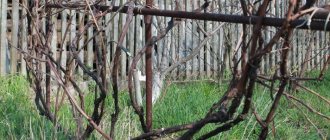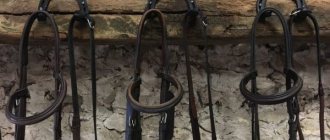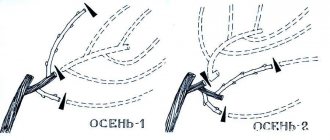Disadvantages of fan formation of a grape bush
However, in some cases, this method has a number of disadvantages that push the winegrower to look for a new method of shaping.
The disadvantages include:
- the proximity of the bunch of grapes to the ground, as a result they are poorly ventilated,
- receive less sunlight and are more susceptible to powdery mildew, botrytis, etc.
- In addition, due to lack of heat during the cool growing season, shoots do not always mature to 8-12 buds.
Forming grapes using the cordon method
Forming grapes using the cordon method is the shape of a grape bush, which is formed from one or several horizontal shoulders (cordons), on which sleeves with fruit shoots are evenly located.
The formation of grapes using the cordon method has a large number of varieties, but the difference is only in the number of shoulders, sleeves and the spatial arrangement of the fruit vines. For example, there are horizontal and vertical cordons. But in covered viticulture, it is the horizontal cordon that is used. So, on one or more sleeves, two or more short sleeves with fruit links are placed.
The main advantage of the method of forming grapes using the cordon method is the fact that such a bush has a large amount of perennial wood, from which it is guaranteed to grow a powerful bush with a high percentage of yield.
Formation of grapes using the cordon tilt method
Based on the listed disadvantages of fan-shaped bush formation, many winegrowers, in risky farming zones, also use a forming method such as cordon tilting
.
This method allows you to eliminate 50-60% of the disadvantages of standardless fan forming.
An oblique cordon is characterized by 1 inclined perennial arm, on which 3 to 10 fruit links are formed. The grape bunches are located 50-150 cm above the ground, well lit and ventilated. The cordon itself accumulates a supply of nutrients well. Thanks to this forming feature, the risk of grape diseases is reduced and the taste of the berries is improved.
What all cordon formations have in common is the presence of a permanent long sleeve, which, depending on the method of formation, can be positioned horizontally, obliquely or vertically.
The essence of forming an oblique cordon is to remove the shoot (future cordon) at an upward angle.
Formation of an annual seedling using the oblique cordon method.
The goal of the first growing season is to form one strong shoot. If it develops poorly, it is necessary to cut the shoot short in the second year of growth and bring out a new one.
To create a slope, it is recommended to plant the seedling at an angle of 15-20 without disturbing the root ball. However, you can also plant it vertically, and in the second year of growth, carefully tie the shoot to the first wire of the trellis.
When planting more than two seedlings in one row, it is necessary to maintain a distance between bushes of at least 2 meters. Consequently, this is what determines the length of the cordon itself. If the shoot has reached 2 meters or more during the growing season, it needs to be cut (pinched) to this length, but no later than the beginning of August so that the shoot has time to ripen before winter. If the spruce shoot has matured less than 2 meters, then it is grown next year.
Formation of a two-year-old seedling using the oblique cordon method.
With the onset of spring of the second planting, fruit shoots will begin to develop on the overwintered shoot (future cordon). When the shoots reach a length of 4-5 cm, it is necessary to remove all shoots at a distance of 35-50 cm from the head of the bush and all shoots growing from the lower buds. Next year these shoots will become the basis for the formation of fruit links. In summer, we pinch the shoots above 10-12 eyes, with the exception of the last one, for better ripening. In mid-October (read about pruning dates here), we shorten all shoots by 4-6 eyes, leaving a reserve in case of an unfavorable wintering.
Formation of a three-year-old grape bush using the oblique cordon method.
When pruning in spring, we cut two-year-old shoots short into 3 buds, one of which is a reserve in case of damage. As a result of shaping, we get the so-called horns.
Rozhok is a two-year-old vine, pruned short. A fruiting link is formed on it with an oblique cordon.
In the summer of the third year, the grapes will produce their first harvest. It is recommended to leave only 2-3 tassels on the bush. It is not advisable to leave more, since the young bush can be overloaded with the harvest. As a result, the bush will weaken and it will take 2-3 years to restore it.
During the growing season of this current code, 3 shoots grow from the horns. In the fall, pruning is carried out in order to leave 2 strong shoots on each horn, removing weak and unnecessary ones.
Formation of a four-year-old grape bush using the oblique cordon method.
In the spring, before the buds begin to bloom, a new fruiting link is formed from the shoots of each horn. Where the lower shoot is cut short, leaving 3-4 eyes (replacement knot), and the upper one is long (on the fruit shoot), leaving 6-12 buds, depending on the variety.
At the beginning of the growth of young shoots, when they reach a length of 6-8 cm, it is necessary to remove all excess growth that grows from the axillary and dormant buds on the cordon. In the fourth year of growth, the grape bush will produce its first real harvest.
When pruning in autumn, all fruit-bearing shoots are cut off with pruning shears, leaving them only on replacement knots, since they form a new fruiting link.
In the spring of the fifth year of growth of the grape bush, we obtain a fully developed plant by forming an oblique cordon.
Pruning shoots on horns should always be trimmed at the fruiting point. It is necessary to remove the fruit-bearing vine, and leave the lower shoot from the replacement knot for replacement, and the upper one for fruiting.
Formation of an adult grape bush using the oblique cordon method.
Pruning adult grape bushes (over 4 years old) consists of forming new fruit links on the horns, where the pruning process is repeated every year. Thus, the lower shoot that grew on the replacement knot will take on the role of a replacement shoot next year, and the upper ripened shoot will become a fruit shoot. All remaining fruit-bearing vines are removed, with the exception of those necessary to give the bush a renewed shape.
Year after year, the horn-sleeves become longer, their wood ages, and productivity decreases. In this regard, it is necessary to form new ones to replace the old horns. To do this, it is necessary to grow a fattening shoot at the very base of the horn, and when pruning, cut it off by 2-3 eyes. Next year, 2-3 new shoots will grow from it, from which the future fruit link will be formed, and the old sleeve will be cut off to form the base.
Note.
Forming a grape bush with an oblique (inclined) cordon is possible using two sleeves. The difference between a double-sided cordon and a single-armed formation is only that in the first two years of seedling growth, 2 shoots are grown, which, after pruning the grapes, are obliquely tied to the bottom wire of the trellis in different directions of the same plane.
Horizontal cordon of Belikova G.V. – shaping and growing grapes
Every tree has a trunk - I think many people know this.
Strangely enough, many people don’t even realize that grapes can have it too. But, not only can it be, but it should be. Know that, secretly from you, he always dreams of becoming a tree. And we stubbornly, belittling his dignity, call him a bush. And if you decide to do justice to your pet, then let's begin! First
, what you need to learn: we will call the trunk a trunk.
Second -
Unlike a tree, the trunk (formerly the trunk) will be located horizontally to the ground (it should be different from a tree in some way).
This provision is necessary for several reasons. But in order not to overload the article, we will call the main reason, of course, the convenience of care and shelter for the winter. The fact that it is necessary to cover grapes has already been understood by many, if not most. But we have run far ahead, we are trying to talk about shelter, although the grapes have not yet been planted. But this is not bad, much worse if it’s the other way around.
Many people know how to prepare a planting hole. Let's skip this point for now. Your task is to concentrate your attention on the main thing. And the main thing for you is to grow just one single shoot and, of course, a healthy one. What could be simpler, but it only seems so. You have only one escape, but there are many misfortunes all around! But, if you approach this matter creatively and with love, then everything will definitely work out. It completely slipped my mind - for the convenience of sheltering for the winter, it is advisable to plant a seedling or cutting at a slight angle, in the direction of the growth of the trunk. It is advisable to avoid all kinds of sharp bending angles during shaping.
So, your shoot is developing, pleased with the growth and color of the foliage. All according to plan. You just need to pluck out the stepsons in time. Your super task: to create a future standard without damage. It will serve you for many years. This is the basis in which all the nutrients so necessary during hard times will be stored. Remember, the more powerful it is (the standard), the easier it is to overcome the vagaries of the weather and other difficulties, and there will be many of them.
By autumn, our hero must gain strength and lay buds for next spring. And now it’s time to accustom him to a horizontal position. Only without fanaticism, gently but persistently. If you do this before frost, everything will work out without effort or injury. In this position he will go to winter...
In the second spring of its existence, the trunk remains in a horizontal position. You just need to tie it to the bottom wire of the trellis (30 cm from ground level).
The weather is favorable, the buds have begun to grow together - the eye is happy. Attention! Don't waste time. We need a standard without damage. And the fact is that not all kidneys are needed.
Here, you will have to make a tedious digression, but there is no way without it. The future standard, it only looks “wooden”, in fact, it is much more complex in structure. We will leave the analysis of details to scientists - they are familiar. And we ourselves will isolate only what is necessary. For now, you need to know that there are two vascular channels inside the trunk. One of them runs along the back, the other along the abdomen. Well, where are these bellies and backs? And they are in plain sight, take a closer look!
The old people said that you should always start dancing from the stove, but we will start from the first kidney. It doesn’t matter to us where the belly is and where the back is. It is important for us to know: where the first kidney is, there is the back, or vice versa. And it is also important that the buds grow diametrically opposite (what a long and nasty word). But the point is the following: let the first bud grow on the back, but the second one will then be on the abdomen. What do we need to understand from this? Here's what: even-numbered buds are fed from one channel, and odd-numbered buds from another. And no other way. This is a grand discovery! You feel how much you respect yourself, how your horizons have expanded! For example, I feel it! But enough chatter, it's time to get down to business.
Related article: Matyas Janos grape variety
It is urgent to remove (before they outgrow) all even or odd buds. More precisely, you need to leave those that look up, and delete those that look down. What if the kidneys look to the side? What if the vine twists around its axis (it can, but this is a very undesirable phenomenon)? This is why we count. If it is still not clear, then we carefully re-read everything from the beginning.
So why are all these dances, stoves, kidneys, in a word, pseudo-scientific nonsense needed? But what are all these efforts for? By removing all the lower buds, we “turn off the lower channel”; over time, it becomes deformed. And the upper channel, on the contrary, will increase.
We admire the work done. The lower buds have been removed, and the upper ones have begun to grow. And again, we are not done!
kidneys are needed. What the hell is wrong with these kidneys?!
So what to do? After all, you are forming long-term formations, and this is something that will last for years. Everything that we leave will subsequently be called a sleeve (or horn), as you like. The distance between the sleeves is approximately 80 cm (6 internodes). There are no rules here. The distance may be different. But usually, the first, seventh, thirteenth, nineteenth buds, etc. are left for the sleeves. The exceptions are technically varieties and varieties of Asian origin. But we'll talk about them later. We remove the remaining kidneys; we don’t need them. Our task is to lay the sleeves without damaging the stem. They also forgot about the very last, top kidney, which will extend our headquarters. The length of the trunk and the number of sleeves depend on the ability of the cordon (the name of the formation) to pull the load.
Formation of cordon grapes for the second year
The second year consists of growing sleeves from last year's shoulder. It is worth noting that the buds on the vine are located above and below. So, future sleeves are grown from the upper eyes, and the lower ones are considered replacement buds, i.e. if something happens, a shoulder can be reconstructed from such a kidney.
So, we select the upper buds and provide them with space for development, removing excess growth points at intervals of 30-80 cm. Such a large spread is due to the fact that each grape variety requires a different arm length, the longer it is, the greater the distance between the arms . The result should be about 4-5 shoots (sleeves), depending on the length of the shoulder. As has already been said, if it’s not enough, we extend it.
Formation of grapes using the cordon method the first year
The first year is very important. It is now that the main shoulder (the main vine) is laid. It can be one (one-armed), two (two-armed) or more, but you shouldn’t get carried away by creating a lot, since the more shoulders, the weaker the bush. It all depends on the variety. If some variety can withstand three or more vines, then please.
It is worth noting that if during the first season the shoulder did not have time to grow and ripen to the planned length, then there is nothing to worry about, since next year the shoulder can be lengthened due to the last matured shoot, giving it the same angle of inclination (the sleeve will become a continuation shoulder), laying along the shoulder. The fact is that young vines are very pliable, so they easily give in when bent and tied to trellises, and over time they become lignified and fixed in a given position. During the process of growth, the shoulder must be tied to the lower horizontal wire and gradually tied up while it grows.
During the growing season, operations such as pinching and minting are carried out. The essence of stepsoning is that three leaves remain on one node: the stepsons of the first order are removed above the third leaf (we get two leaves), the stepsons of the second order are completely removed and one more main leaf remains. A total of three sheets. Chasing is the removal of the growing point at the end of summer to stimulate the ripening of the shoot.
Formation of grapes inclined cordon
Let us consider, as an example, a scheme for trimming an inclined horizontal cordon. The fact is that this method is most suitable for covering grapes, since such grapes are easiest to remove from the surface of the trellis every year before wintering and cover them.
First, you need to remember a few concepts. The shoulder is the main perennial vine, which is the fundamental link of the entire future bush. Sleeve - vines that grew on the shoulder and on which fruit vines subsequently grow.
Many beginners make the huge mistake of thinking that they can complete the entire three-year scheme in one year. This can weaken the bush and as a result, there will be a weak harvest with small sparse clusters or no harvest at all. So you need to be patient in order to create a uniform, powerfully developing plant that will bear fruit year after year in juicy, large and abundant clusters.
Related article: The work of leaves - The life of a grape plant
